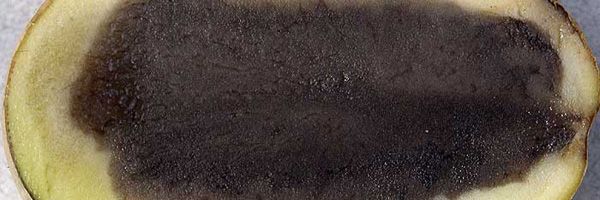
Black heart
- Symptoms
Black heart is characterised by black colouration at the centre of the tuber.
The affected tissues form clearly delineated spots, irregular in pattern, that remain quite firm (photo 1) and which sometimes contain small cavities whose walls are not, as in the case of hollow heart, covered with healing cork. The pigment responsible for the black colour is the same as that responsible for the internal blackening: melanin.
With seed potato tubers, the diseased plants germinate badly and produce weak plants.
- Risk factors
Whilst black heart sometimes appears in the field when the soil is saturated with water or during very hot temperatures, in the majority of cases it affects tubers during their storage or during their transport in hot and badly ventilated conditions. A long exposure to temperatures of around 0°C can also cause the damage.
Black heart is caused by a lack of oxygen or an excess of CO2 in the surrounding air which creates an asphyxiating environment.
Generally speaking, a lack of oxygen in storage occurs in the following cases:
-
storage at a high temperature (8 to 10°C) in an airtight building with no air renewal over a long period;
-
storage at low temperatures (below 2°C) in an airtight building (e.g. cold room) with no possibility of automatic air renewal;
-
tubers being warmed, before handling, by hot air generators placed inside the building with no extraction of the bad air;
-
increasing the air temperature to too high a level compared to the temperature of the stored tubers.
- Control
In order to prevent the development of blackheart, it is recommended to:
- avoid badly drained soils and over-irrigation;
- prepare the soil to give a structure and porosity that allows air circulation;
- avoid harvesting in extreme heat (around 30°C) or excessively low temperatures (around 0°C);
- maintain a moderate temperature during cold storage
- dry tubers quickly to avoid condensation which may lower air exchanges;
- maintain an adequate ventilation during transport and storage to avoid asphyxia of the tuber;
- avoid storing tuber in tightly closed places.





